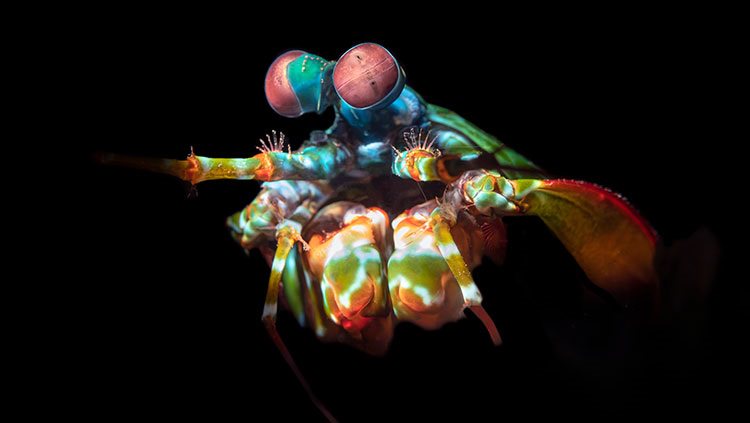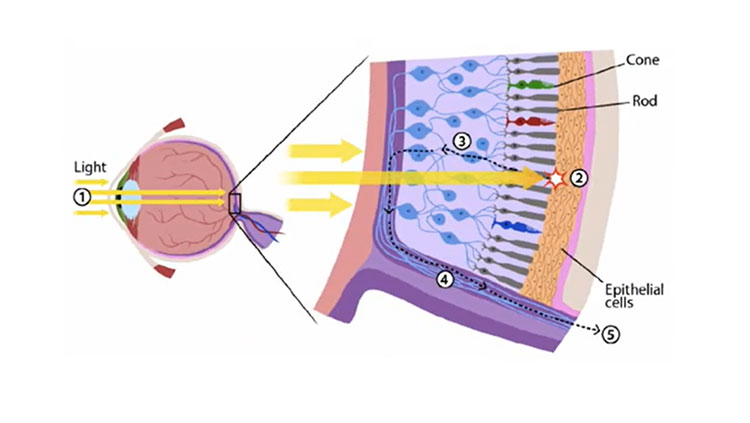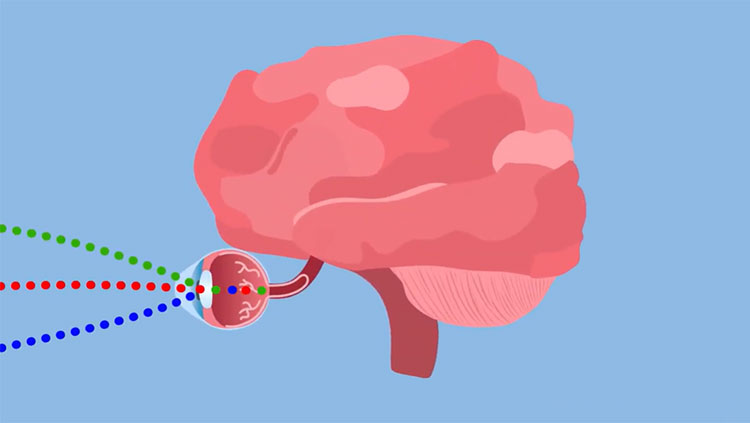Beyond the Rainbow: The Incredible Visual World of Fishes
- Published30 Sep 2022
- Author Ravindra Palavalli Nettimi
- Source BrainFacts/SfN
Beauty is in the eyes of the beholder, both in philosophical and scientific contexts.
The universe is filled with electromagnetic radiation, a form of energy we also know as light. Represented as a spectrum of defined wavelengths, longer wavelengths include infrared, microwaves, and radio waves. Shorter wavelengths of light include X-rays and ultraviolet (UV) light. Between infrared and UV wavelengths is the rainbow of colors humans perceive and call visible light.


Many organisms detect wavelengths of light beyond that rainbow. Humans see only a sliver of the visual world because our photoreceptor cells called cones detect only specific components of the electromagnetic spectrum.
Humans have three types of cones (red-sensing, green-sensing, and blue-sensing) to detect what we know as visible light (violet ~400 nm to red ~700 nm). An animal’s ability to detect light varies among species, as their visual needs have evolved to suit their environment. A fish in your aquarium, for example, may see the properties of light inaccessible to your eyes.
Dive in and explore some common fish that can see beyond what humans see.
Salmon

Salmon are famous for migrating from saltwater to freshwater where they were born, and their visual abilities change as they progress through life. For example, sockeye salmon at pre-adult stage, also known as smolt, have fewer UV cones than juvenile salmon. But as they mature from smolt to adult, they regain their UV cones. Because UV light penetrates the water, scatters, and creates a silhouette of prey, it may improve their foraging efficiency. Juvenile and adult salmon can easily detect their prey against a UV background.
When adult salmon migrate from saltwater to freshwater in order to spawn, they can also sense infrared light. They achieve the feat by slightly modifying the vitamin A molecules in their retina. Infrared vision allows them to see better at night in shallow and murky freshwater because moonlight entering shallow freshwater is rich in red and infrared wavelengths. Salmon essentially switch to night vision to see in murky waters.
Trout
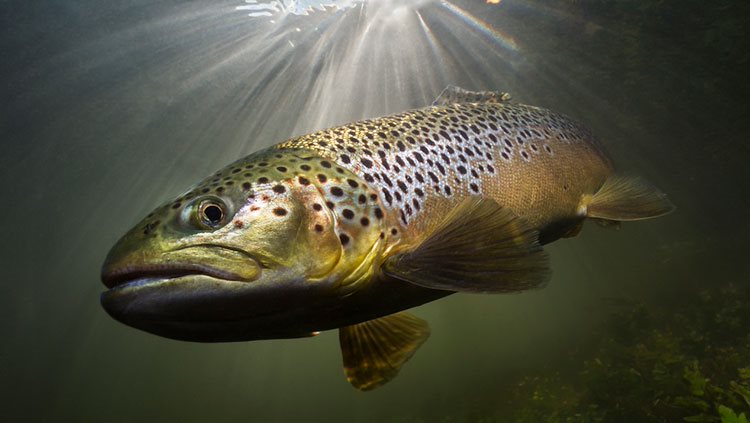
Trout are salmon relatives that live in freshwater lakes and rivers. But, unlike salmon, adult brown trout lack UV-sensitive cones. Because adult trout lose UV vision as they age, their lenses absorb UV light to protect the retina from some harmful effects of UV light. In juvenile trout, UV vision may aid in foraging for drifting plankton. They can detect delicious floating food thanks to scattered UV light in clear water. Adults do not need to detect floating plankton because they are mostly bottom feeders. So, vision in trout tends to match their foraging habits.
Common carp
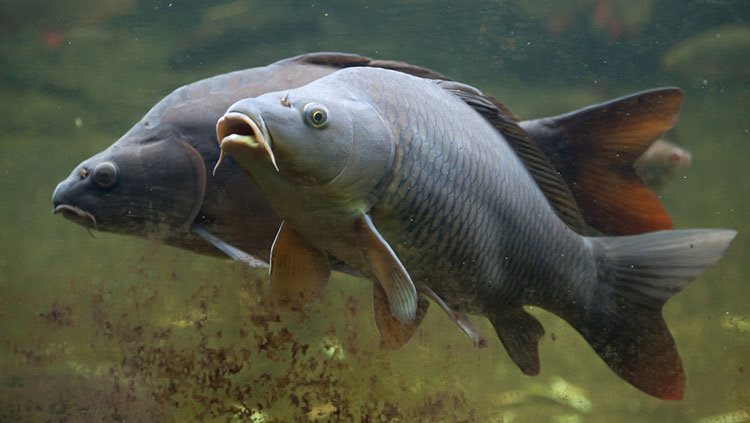
Common freshwater carp dwell in the turbid eutrophic waters of lakes and rivers rich in nutrients and minerals. When light enters such water, suspended particles absorb and scatter shorter wavelengths. When shallow, the lack of shorter wavelengths results in an abundance of red and near-infrared wavelengths. Carp possess photoreceptor cells sensitive to near-infrared wavelengths at 865 nm, allowing them to detect near-infrared light. Their ability to detect infrared wavelengths increases the sensitivity of their eyes and allows for better night vision.
Goldfish

In an everchanging world, a goldfish’s vision adapts. These popular freshwater aquarium pets related to carp usually have tetrachromatic color vision. Besides red, blue, and green cones, they also have UV-sensitive cones. But the UV sensitivity of some goldfish species decreases as they become adults. UV sensitivity may be a life stage-specific adaptation to changing feeding habits.
Zebrafish

Zebrafish eyes develop like ours and are easy to manipulate genetically. As a result, scientists use them to investigate human optical defects such as myopia and glaucoma. However, unlike most humans, zebrafish are tetrachromats. Like goldfish, they can detect light with wavelengths ranging from UV to red. Zebrafish larvae can also sense near-infrared light at 860 nm. But, at night, they turn off their visual system and reduce their activity. Maintaining vision, like using your phone’s camera, demands a lot of energy. Reduced photoreceptor activity may assist baby zebrafish in conserving energy as they forage for themselves.
We may never be able to see the world through the eyes of a fish. But we can catch a glimpse of their worlds as scientists unravel the visual perception of these common underwater creatures.
CONTENT PROVIDED BY
BrainFacts/SfN
References
Bowmaker, J. K., & Kunz, Y. W. (1987). Ultraviolet receptors, tetrachromatic colour vision and retinal mosaics in the brown trout (Salmo trutta): Age-dependent changes. Vision Research, 27(12), 2101–2108. https://doi.org/10.1016/0042-6989(87)90124-6
Bowmaker, J. K., Thorpe, A., & Douglas, R. H. (1991). Ultraviolet-sensitive cones in the goldfish. Vision Research, 31(3), 349–352. https://doi.org/10.1016/0042-6989(91)90087-L
Chen, D.-M., & Stark, W. S. (1994). Electroretinographic analysis of ultraviolet sensitivity in juvenile and adult goldfish retinas. Vision Research, 34(22), 2941–2944. https://doi.org/10.1016/0042-6989(94)90265-8
Emran, F., Rihel, J., Adolph, A. R., & Dowling, J. E. (2010). Zebrafish larvae lose vision at night. Proceedings of the National Academy of Sciences, 107(13), 6034–6039. https://doi.org/10.1073/pnas.0914718107
Gestri, G., Link, B. A., & Neuhauss, S. C. F. (2012). The visual system of zebrafish and its use to model human ocular Diseases. Developmental Neurobiology, 72(3), 302–327. https://doi.org/10.1002/dneu.20919
Hartmann, S., Vogt, R., Kunze, J., Rauschert, A., Kuhnert, K.-D., Wanzenböck, J., Lamatsch, D. K., & Witte, K. (2018). Zebrafish larvae show negative phototaxis to near-infrared light. PLOS ONE, 13(11), e0207264. https://doi.org/10.1371/journal.pone.0207264
Land, M. F., & Nilsson, D.-E. (2012). Animal eyes (2nd ed). Oxford University Press.
Losey, G. S., Cronin, T. W., Goldsmith, T. H., Hyde, D., Marshall, N. J., & McFarland, W. N. (1999). The UV visual world of fishes: A review. Journal of Fish Biology, 54(5), 921–943. https://doi.org/10.1111/j.1095-8649.1999.tb00848.x
Matsumoto, T., & Kawamura, G. (2005). The eyes of the common carp and Nile tilapia are sensitive to near-infrared. Fisheries Science, 71(2), 350–355. https://doi.org/10.1111/j.1444-2906.2005.00971.x
National Aeronautics and Space Administration, Science Mission Directorate. (2010). Visible Light. Retrieved [September 22, 2022], from NASA Science website: http://science.nasa.gov/ems/09_visiblelight
Neumeyer, C., & Arnold, K. (1989). Tetrachromatic color vision in the goldfish becomes trichromatic under white adaptation light of moderate intensity. Vision Research, 29(12), 1719–1727. https://doi.org/10.1016/0042-6989(89)90154-5
Novales Flamarique, I. (2000). The ontogeny of ultraviolet sensitivity, cone disappearance and regeneration in the sockeye salmon Oncorhynchus nerka. Journal of Experimental Biology, 203(7), 1161–1172. https://doi.org/10.1242/jeb.203.7.1161
Shcherbakov, D., Knörzer, A., Espenhahn, S., Hilbig, R., Haas, U., & Blum, M. (2013). Sensitivity differences in fish offer near-infrared vision as an adaptable evolutionary trait. PLoS ONE, 8(5), e64429. https://doi.org/10.1371/journal.pone.0064429
Sliney, D. H. (2016). What is light? The visible spectrum and beyond. Eye, 30(2), 222–229. https://doi.org/10.1038/eye.2015.252
Thorpe, J. E. (1988). Salmon migration. Science Progress, 72(3), 345–370.
U.S. Department of Health and Human Services. (2022, July 5). Protecting your eyes from the Sun's UV light. National Eye Institute. Retrieved September 9, 2022, from https://www.nei.nih.gov/about/news-and-events/news/protecting-your-eyes-suns-uv-light
U.S. Department of the Interior. (n.d.). The Salmon Life Cycle. National Parks Service. Retrieved September 9, 2022, from https://www.nps.gov/olym/learn/nature/the-salmon-life-cycle.htm
Yong, E. (2015, November 12). How salmon switch on infrared vision when swimming upstream. The Atlantic. https://www.theatlantic.com/science/archive/2015/11/how-salmon-gain-infrared-vision-when-swimming-upstream/415368/
What to Read Next
Also In Vision
Trending
Popular articles on BrainFacts.org



